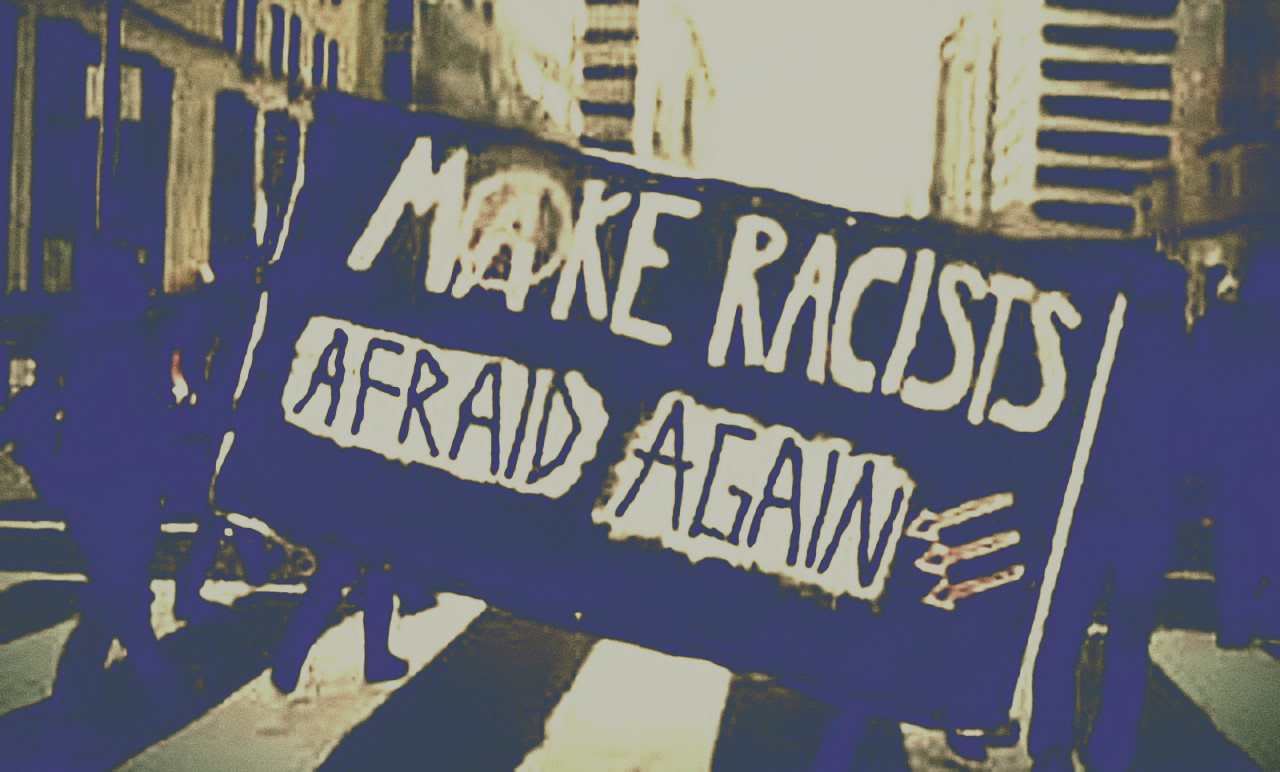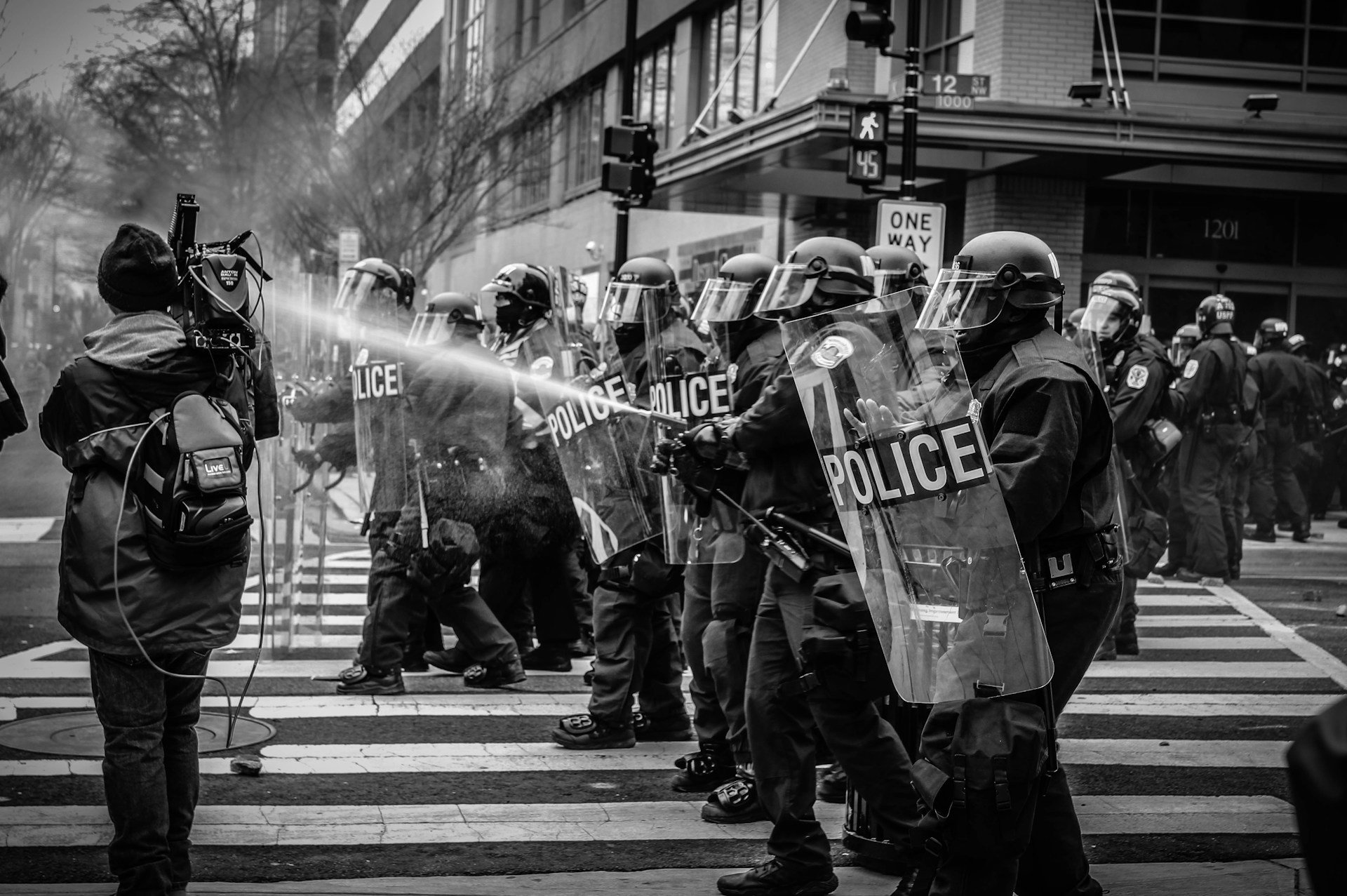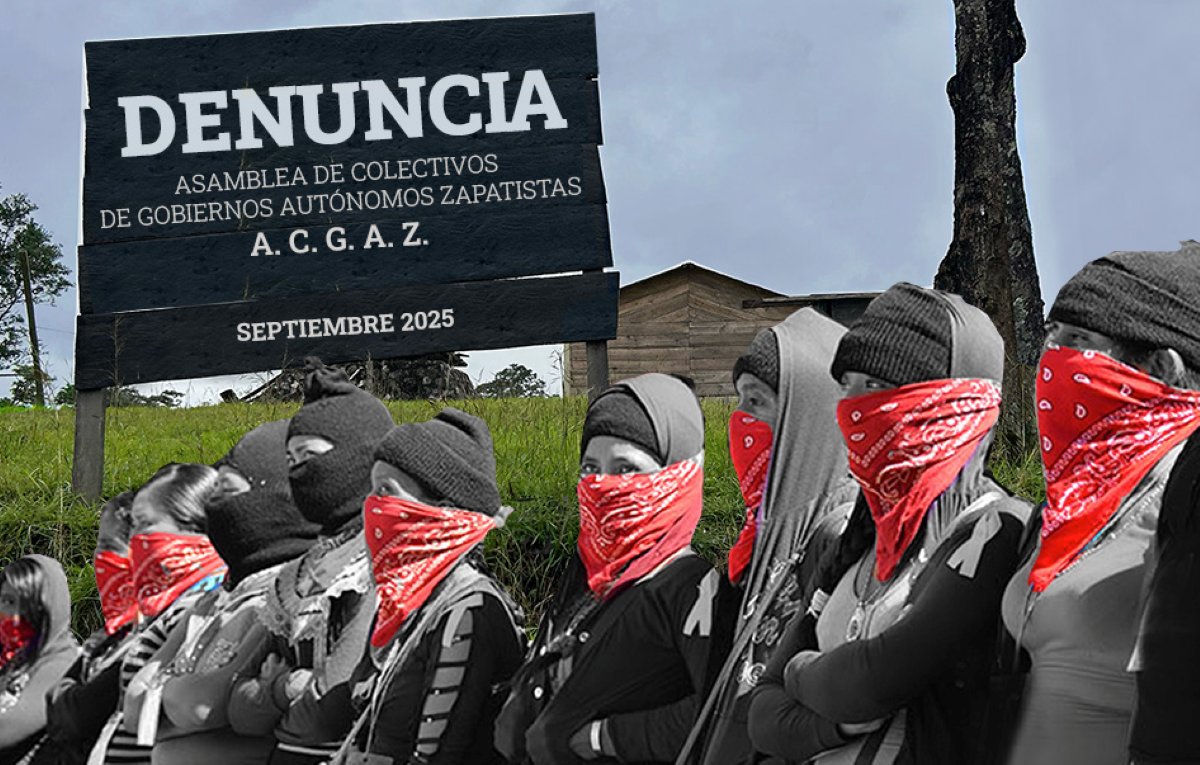Filed under: Anarchist Movement, Anti-fascist, Critique, US, White Supremacy

A critical look at the current antifascist movement and how it could evolve in the changing terrain. This essay was originally published in Teeth, a print-only anarchist journal. Download and print a zine PDF here.
By Stiff
A note to readers: The following opinions and analyses are largely my own. However, the finer details described here are inspired and informed by dozens of conversations with antifascists residing in various regions of the so-called US. I encourage readers to integrate these ideas into their own work and use the following reflections and analysis as a jumping-off point to collectively develop antifascist thinking through dialogue and action.
Antifascism in the so-called United States has become a toothless movement. After effectively responding to the rise of the Alt-Right in the 2010s, the wider antifascist movement now spends more time maintaining the vestiges of an identity rather than effectively engaging with and countering fascist tactics, organizational growth, and ideological development. Of course, there are indeed some antifascists who do otherwise. But the overall malaise and impotence antifascism has grown into as a social movement cannot be understated. This shift necessitates immediate actions be taken to reverse that course in the face of fascist growth. In this essay, I will define and describe some defining features of contemporary antifascism, discuss ways to strengthen the antifascist movement, revisit the past decade of movement development on both fascist and antifascist sides, and finally, cover one contemporary fascist threat and how we might better prepare and act accordingly.
For A Strong Movement
Antifascism is a social and political movement designed to counter, interrupt, and stop fascist organizing. The key tactical approaches to antifascism are direct confrontation, demoralization, and isolation. The goals of antifascist groups vary but generally involve preventing fascists from securing public platforms, and preventing bodily harm to community members, especially historically marginalized ones, from fascist violence. The focus of organized antifascism, whether it occurs in a formal crew structure, an armed militia, or a nebulous autonomy is not to end fascist thought altogether but to never let it actualize as a social movement with power. Historically, this has meant directly confronting fascists and their organizational structures in the spaces we meet them—be it public or private.
As a social movement, building and maintaining strength and longevity necessitates an organizational focus on building a base and furthering discourse. As anarchists, we’ve built upon a a long lineage of community organizing using an anti-authoritarian and non-hierarchical framework. This has furthered the anarchist movement across tendencies, leading to the birth of new tendencies that strengthen the movement’s base and radical potential. Anarchism has expanded, contracted, broadened and refined itself throughout generations by remaining discursive. By getting clear on how and why we act—whether through conversations around the camp fire or information shared in zines and communiques—we sharpen our ideas, imagine the possibilities of our actions, while remaining interconnected and autonomous. The antifascist movement needs to more deliberately strive for the same base-building and discursive progress anarchism has achieved.
One way of building a stronger base for the antifascist movement is taking radical antifascism to the targets of fascist violence and ideology. If there is to be any backbone in the age old saying “we go where they go,” antifascism needs to develop itself more explicitly within the struggles around homelessness, immigration, bodily autonomy, LGBTQIA+, antisemitism, zionism, and feminism. Each of these currents is connected to a wider anarchic struggle, and each of these currents is a direct target of fascist agendas. For example, if we understand homelessness as a phenomenon disproportionately experienced by LGBTQ community members, Black folks, and other groups who lack the benefits of Whiteness, cisness, and other forms of financial, social and cultural capital, then homelessness becomes a politicized issue worthy of anarchist attention. When homelessness is further contextualized as a vulnerable status that fascists, who by ideological design prey on vulnerability, seek to exacerbate through humiliation, domination, and violence, homelessness also becomes an antifascist struggle. Learning to see social issues through an anarchist lens and then translating that into base building means bolstering our collective power as antifascists. Many hands make light work. Broadening our visions of antifascist struggle to collectivize our efforts makes our goals more achievable, and keeps our global community safer.
Along with building out a stronger base, it is crucial to intentionally further antifascist discourse. Discourse is the interchange of knowledge, ideas, and expressions of thought on a given subject. If we think about the movement side of social movements, there is an an ongoing self-determination and progression by the actions of participants. An example would be the discourse of ‘propaganda of the deed’ by anarchists – which was not just contextualized in communiques and anarchist papers, but by the deeds themselves. If we antifascists are to be truly discursive, we must do so with a balanced approach of theory and action. Antifascists have well developed research and analysis skills, strengthened out of necessity for fine-tuning our offensive strategies on an often diffuse enemy. For example, if we take the time to utilize those same skills to synthesize ideas like Race Treason1 into our political analyses and if we are explicit about how activism is not struggle and therefore has no place in antifascism, we stand to gain a level of integrity and a depth to our collective cohesion that multiplies our potential across our movement.
Drawing Our Lines
In order for antifascism to remain radical, it has to be situated within the three-way fight2 position and grounded by an anarcha-feminist framework3. Incorporating the three-way fight and anarcha-feminism into antifascism is non-negotiable. The enemy of antifascism is not just the fascists themselves, but the capitalist system that creates the conditions suitable for fascism. At the same time, antifascism must combat the patriarchal and hyper-masculine domination of its spaces, discourse and conceptualization.
The three-way fight posits “defending democracy” as an illusion as long as “democracy” is based on a socio-economic order that exploits and oppresses. Fascists and other far-Rightists aren’t always tools of and loyal to the ruling class and established order. They can— and do— form autonomous political forces that clash with established order in real ways. At times, they even seek to overthrow and replace global capitalism with a radically different yet still oppressive system. The three-way fight stresses the need to confront both the established capitalist order and an insurgent fascist Right, while recognizing that these opponents are also in conflict with each other. The phrase “three-way fight” is shorthand for this idea. Anarcha-feminism sees the manifestations of patriarchy and body and gender essentialism as hierarchies woven into the fabric of both the state and social order, including the anarchist movement itself. An anarcha-feminist lens understands these as essential elements of what the anarchist struggle must seek to destroy—within the world and within our selves. For these theoretical positions to have meaning, they must move beyond just theory and be put into practice to create a material difference in the character of antifascism.
A clarification between what will be defined here as material antifascism and theoretical antifascism is essential. Material antifascism refers to the praxis of material engagement with the fascist threat. Theoretical antifascism, on the other hand, refers to the theoretical or ideological position of being against fascism but absent of any such material engagement. Theoretical antifascism is inherently antithetical to material antifascism. This is not to say that antifascists can only be effective if they each physically confront the fascists in the streets, but that if there is a complete lack of material engagement with fascist base-building then we cannot consider the contribution to antifascism as holistic.
In 2024, many people call themselves antifascists but mean it as an ideological or theoretical position only. This sounds like, “I hate fascists (and they hate me!) but I will only act against them when…” It’s also true that many organized antifascists, especially in the Anti-Fascist Action-style crew formation, are simply no longer engaging with fascism in any material way. If a name means anything, then ‘Anti-Fascist Action’ should clearly necessitate the act. To continue to maintain a crew name or structure with no effort at material engagement is living into a farcical reality that only adds to the stagnation of the antifascist movement as a whole.
How We Got Here
In this next section, I will discuss the broader development of fascism and antifascism across the so-called US over the last decade.
The Trump presidential campaign leading up to the 2016 election included a clear rise in openly fascist network building, recruitment, formation, and activity. Groups like the Traditionalist Worker Party, Patriot Front, Identity Evropa, Rise Above Movement, and others were all born directly from the swells of the Alt-Right. The Alt-Right was a White Nationalist ideological movement characterized by a rejection of mainstream politics and by the use of aesthetically slick graphics and provocative online media to cultivate views. Although it was started by Richard Spencer in 2008, it didn’t take off until the 2010s. The Alt-Right brought together major movers and shakers from the broader and aging White Nationalist scene (e.g. League of the South, American Renaissance , Ku Klux Klan, National Socialist Movement, etc.) with more youthful tact and appearance newcomers like the Matthew Heimbach of Traditionalist Worker Party, Andrew Anglin of The Daily Stormer, and Milo Yiannopoulos.
The Alt-Right advanced white nationalist narratives and talking points across the internet, throughout gamer culture, and on college campuses nationwide. It targeted and recruited mostly young, lonely, and otherwise disaffected cis white men to the White Nationalist movement with tactical success. In many ways, the Alt-Right did what boneheads did in the 80’s and 90’s in cities, just at a larger scale. Instead of plucking a handful of individuals vulnerable to nationalist dogma from punk rock or other alternative scenes, the Alt-Right reached thousands of kids and young adults using technology. From the comfort of their homes using smartphones and laptops, new recruits lapped up repackaged White Nationalist lies all at once.
What antifascists don’t mention enough is that we were seeing private nazi group chats planning to attend Trump’s ‘Make America Great Again’ rallies together in real-time. What we saw within these group chats was individuals planning not to physically identify themselves as fascist group members, but instead to wear plain clothes and don MAGA hats. Rather than luring conservatives toward their fascist and nazi organizations through their own events, organized members of the Alt-Right siphoned a vicarious semblance of collective power directly from Trump’s rallies. It made sense, after all, since Trump rallies already enthusiastically supported authoritarian White Nationalist values. From June 2015 to November 2016, the 2016 Trump presidential campaign held 323 rallies, with many of the more modestly attended crowds in the thousands.
Of course, established fascist groups still held their own meetings, marches, and rallies, and new groups were popping up routinely. It was during this time that fascists built numbers and gained momentum alongside the bubbling conservative right. This rapid growth and the successive events meant an extended space and time in which open conflicts between antifascists and fascists were both more possible and more common without immediate police intervention. In respect to fascist attendance at Trump rallies, the MAGA crowds were big enough at these rallies that the cops could turn a blind eye to any violence dealt out by those they were rooting for anyways, as they like to do. But organized antifascists were often more capable and grittier than many of the recently recruited fascists were ready for.
A solid contingent of organized antifascists and AFA crews descended directly from street movements and direct action, while a huge swathe of the newly radicalized fascists had built a false sense of safety and security in the online camaraderie of nazi forums and chat groups. Their offline experience was a rude awakening. Much like the movement battles between fascists and antifascists in decades before, antifascists successfully used a combination of confrontational tactics to demoralize these newer fascists and kept many of them from coming out to any more rallies. Not all of them stayed home. Consistently meeting fascists with material force will demoralize most, some to the point of quitting the movement altogether. But those that stay either stay because they are dumb enough to or they embrace the violence and harden themselves to their new understanding of this positionality.
Antifascists won the streets from the far-Right and fascist surge in the late 2010s after the Unite the Right rally in Charlottesville. Parsing out the detailed denouement of the Alt-Right in the direct aftermath of Unite the Right is worthy of it’s own essay, so this will be kept brief. Unite the Right was the pinnacle of the Alt-Right movement’s effective facilitation of renewed fascist street presence, and brought out membership from well over a dozen different white nationalist and fascist formations. Antifascists had decidedly won the pitched battle in and around the park that day, before Vanguard America neo-Nazi James Alex Fields Jr. drove his car through the antifascist victory march injuring over thirty people and murdering antifascist Heather Heyer. This escalation from street fight to successful public murder at a massively attended demonstration took off in the mainstream media. The fascist street formations and their members were condemned to an inexorable amount of social and institutional pressure in the years to follow, the legal battles for some are still ongoing as of this writing.
The wider antifascist goals of demoralization and isolation were successful, and the fascist groups who didn’t disband altogether either fell back to a sole reliance on private, unannounced events or to the perceived safety of their online chats to inch onward. With popular recognition as an effective movement in the era of the Alt-Right, antifascists won hard-fought victories in the streets. Burnout, repression, and interpersonal conflict have long plagued our movements and in the wake of larger relative success, the organized antifascist movement was simultaneously eroding at its core. As the momentum of open, street-level fascist organizing and action largely petered out, a popularized version of internet antifascism turned the focus of the movement’s efforts toward a largely journalistic approach. We go where they go and there was a boom of internet nazis gaining popular power in the age of social media. Unfortunately for antifascists, shares and likes matured into a dilution of praxis rather than a distillation.
All Bark No Bite
Antifascists have always used research and exposure to demoralize nazis . Done well, research helps antifascists understand our enemies. Exposure in the form of doxing opens up the possibility for material engagement with fascists themselves. But in the same way we know better than to rely on the cops or courts to take down fascists, we can’t rely on just anyone who reads our articles or sees our dox flyers to materially engage the fascist threats we explain to them. The point of exposing a fascist is the implicit threat of a reckoning to come for the fascist and the threat which we consider them. If we aren’t following through after the dox, our threat is hollow and puts us at a disadvantage moving forward. In other words, all bark and no bite does not get the goods. It renders the bark useless.
Consider boxing as an example. Most people have heard of a 1-2 punch, which corresponds to the punch combination of a jab (1) followed by a cross (2). When you throw a jab, you also step forward with your front foot. The step establishes distance, exemplifying their position isn’t as safe as they thought. The jab checks your opponent’s guard, potentially exposing an opening or weakness from their reaction to the jab. The cross follows it up; a punch launched from the weight of your back foot and across your body, with a lot more power behind it. The cross does the real damage in this combination and is meant to hurt. After your opponent opens their guard or is thrown off balance by the set-up jab, the cross comes next with the intention of making your opponent rethink how they’ve gotten into the mess they are in. The 1-2 is effective because the punches work with one another for a greater overall impact.
Tactically speaking, doxing someone is like a jab. Antifascists have leaned on a good jab without following it up for too long, rendering the jab less effective. Part of the problem has been myopia, a short-sighted focus on doxing everyone we can as soon as their identity is uncovered and calling that antifascism. There have even been calls for other antifascists not to act on known fascist identities in their area in the name of protecting sources. Meanwhile the fascists we’re fighting have stopped being intimidated by doxing altogether, comfortable in understanding the threat of truly being hurt by a proverbial cross after public exposure is oftentimes, never coming.
A Threat to Consider
Suffice to say, fascists movements have changed a lot over the past decade. As I write this in 2024, we have various groups and undercurrents worth paying attention to and understanding as comprehensibly as possible in order to uncover how to subvert them best. One of the most important contemporary developments of the fascist movement to understand is Nationalism 3.0. Nationalism 3.0 was started by Rob Rundo of the Rise Above Movement in December of 2020. It is a fascist theoretical step forward, taking the ethos of hardened street-fighting nazi skinheads from the 80s, 90s, and early 2000s (1.0) and the front-line combatants from the more well-dressed Alt-Right identitarians of the 2010s (2.0), and synthesizing these past currents’ strengths for a redefined chapter of ultranationalist development. Nationalism 3.0 also has a robust focus on security culture, a key adaptation designed to help protect its adherents from antifascists.
The Active Club is the practical manifestation of Nationalism 3.0 and the framework for organizing its base. Active Clubs emphasize identity formation and camaraderie with the intent to “awaken racial bonds.” Through a lifestylism described as “counter to the left’s culture of apathy, addiction and vice,” active clubs focus on embodying their vision of the ideal white male in a clean-cut, physically fit, innocuous presentation of their members. These groups find strength in remaining purposefully disparate and small in numbers. They also have upped their security culture practices which prevents doxing, and they are building affinity regularly through in-person meetups to fight-train and put up graffiti, stickers, and wheatpaste.
Anarchists understand the effective and extensive possibilities affinity groups can accomplish when confidence and attunement develop. Nationalism 3.0 has moved the counter-cultural fascist infestation from the punk scene to the gym scene as its core recruiting grounds targeting young white men. It’s subcultural base-building has been insufficiently addressed by the wider antifascist movement. This is a call for antifascists to get off our heels and act, or else the problem will only intensify.
Collective Power Punch
When our movements wane—due to burnout, repression, internal strife, misdirection, etc.—discursive and intergenerational continuity is lost. When intergenerational continuity is lost, we don’t successfully pass on our learned lessons and collective wisdom to the next generation of the movement. Mistakes are made over again; tactical decisions are reshaped from scratch. When we don’t figure out how to cultivate intergenerational continuity, our potential growth suffers. Different aspects and pockets of the anarchist movement have developed successful paths to maintain that continuity. As a social movement with anti-social tendencies, antifascism needs to figure out how to do likewise.
There is a ferocity and intention in the current wave of direct, combative action spreading throughout the so-called US and international insurrectionary anarchist milieu. Antifascists would do well to take a leaf from this book and expand on that offensive strategy toward explicit fascist targets. Antifascism is not just a street-fighting mechanism. It is not just a mass movement campaign. And it is not just a journalistic endeavor. A diversity of tactics refers to when a social movement makes use of a variety of tactics, anything from non-violence to armed conflict, to maximize the chances of meeting movement goals. Utilizing a diversity of tactics gives us the space to creatively and more openly utilize direct action against the fascists and their infrastructure – so we can truly devastate them.
Insurrectionary anarchism4 finds strength in its formulation as a movement of practical action against the domination of the state that is most often enacted by individuals and small groups. The ability of antifascism to socially scale up or scale down depending on context has often been a point of strength for organized antifascists to act just as practically, but unfortunately acting as individuals or even small groups has fallen out of practice as the movement has stagnated. If antifascism can find its footing in nebulous, self-organized autonomy of offensive strategy on a smaller scale and collectivized power and discursive depth on a larger scale, our collective counter punch can be the collective power punch we need to win.
This is a call for the antifascist movement to renew directly combative strategies and actions against organizing fascists. This is also a call for the antifascist movement to re-establish itself as an effective social movement by actively building a broad base rooted in the three-way fight and revolutionary anarcha-feminist positions and furthering our discourse through both theory and material engagement. As antifascists, we need to develop a means of intergenerational continuity and draw on other traditions of resistance to expand both our means and our ambitions. As the global capitalist system continues to choke out life and consolidate power for elites as designed, the fascist threat will perpetually exist. So long as that threat exists, antifascists must take that threat seriously, and by any means necessary, we must act like we intend to win.
Further Reading:
- Race Treason and May 28th: A Reflection on the George Floyd Uprising, Living and Fighting, June 2024
- Three-Way Fight Revolutionary Anti-Fascism and Armed Self-Defense, J. Clark, April 2016
- Anti-Fascism Beyond Machismo: Gender, Politics, and the Struggle Against Fascism, Petronella Lee, October 2019
- Insurrectionary Anarchy: Organizing for Attack, Anonymous, 2003





